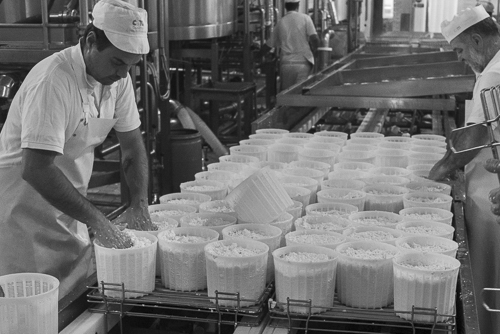Certainly, when people started migrating from the Middle East about 10.000 years ago, they brought domestic animals like cows, goats and sheep with them, meaning that the people who arrived at the Italian peninsula had the same type of domestic animals. Some mllennia later, the Romans arrived and their economy was always based on agriculture and animals husbandry and this continued until about 1900. With dry and hot summers and cold winters, sheep were well adapted to live in Tuscany, while life was more difficult for cows. When 21 sheep farmers founded the dairy cooperative Caseificio Sociale Manciano, they certainly brought along ancient traditions. Initially, the dairy was in Manciano, but it was moved to its present location in the 1990s because the dairy couldn’t expand where it was.
At maximum, there were 600 members in the cooperative, but now there are 150. Before, there were many small producers with 20-30 sheep and 2-3 cows, while nowadays they have at least 200 animals. The farms are increasing because sometimes the children of the farmers don’t want to be farmers themselves, there are many rules which have to be followed, wolves are attacking sheep, the price of milk is ridiculously low and even more causes leading to that small farms are disappearing.
I entered the dairy with a guide who showed me how cheese is made at this dairy. In fact, how to make cheese is the same for a shepherd with a flock of sheep and who makes cheese outside and a modern dairy. The differences consist of: the shepherd filters the milk by pouring it through a cloth into a bucket, while tank trucks bring milk from surrounding farms to the dairy where it is stored in big steel containers, then parts of the milk are subject to chemical and microbiological analyses in order to assure maximum quality and dietary security, the shepherd starts making cheese at once, while here the milk is pasteurised at 70°C, the shepherd collects cheese mass by hand and hangs it up by means of a piece of porous cloth, while here pieces of cheese mass is laid in porous plastic containers, the shepherd stores the cheeses on wooden shelves, while here cheeses are stored on shelves of steel in a large room at low temperature and high humiidty. The shepherd doesn’t package his cheeses, while here they are cleaned, packaged, weighed and labelled.
However, the similarities consist of heating the milk to about 38°C, adding rennet , that is lactic acid bacteria, in order to let the milk coagulate, wait about half an hour in order to let the milk turn into curd, divide it into small pieces, extract the fat parts from the liquid part which is called whey , store the fat parts or cheese mass in porous containers and compressing the cheese to press out whey, next let the whey get out by means of gravitation, adding salt in order to kill dangerous bacteria and turn the cheeses around in order to expel more whey.
During our visit, we could observe a woman who turned around containers with cheese incredibly fast. When she had turned all of them around, she put a lid on the metal container in which all the cheeses had been laid and filled it with vapour in order to get rid of whey. This operation has to be done 3-4 times and, according to my guide, it’s a delicate and difficult task. Obviously, there are still operations which are done better manually than by machine.
Regarding adding salt, the cheeses are submerged in salt water.
This dairy produces, among others, two sheep’s cheeses called Pecorino Toscano DOC, which is aged for at least 20 days, and Pecorino Toscano DOC Stagionato, which is aged for at least 120 days. A particular sheep’s cheese is called Pecorino Briaco, which after a short time of aging, is totally immersed in pomace or marc inside special types of containers for 20 to 30 days. This operation ensures that the fragrance of the marc is given to the cheese.
This dairy also makes a particular type of Pecorino Toscano DOC with the additional label «Amici di cuore» meaning «heart’s friends» because people who eat it, will, in general get a lower level of cholesterol. This is obtained in collaboration with scientists from the University of Pisa who have composed a mixture of soya beans, seeds of flax and olive oil. Specifically, when sheep eat a mixture of these ingredients, their milk contains more unsaturated fat and less saturated fat, which are harmful for people with high levelsof cholesterol.
This dairy has also carried out a programme for lowering their emissions of carbon dioxide in order to minimise their contribution to the greenhouse effect.

